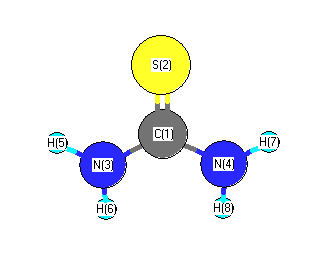Vibrational Frequencies calculated at BLYP/6-31G*
| Mode Number |
Symmetry |
Frequency
(cm-1) |
Scaled Frequency
(cm-1) |
IR Intensities
(km mol-1) |
Raman Act
(Å4/u) |
Dep P |
Dep U |
|---|
| 1 |
A |
3561 |
3532 |
5.17 |
|
|
|
| 2 |
A |
3428 |
3400 |
0.36 |
|
|
|
| 3 |
A |
1635 |
1622 |
47.07 |
|
|
|
| 4 |
A |
1381 |
1370 |
222.60 |
|
|
|
| 5 |
A |
1047 |
1039 |
49.69 |
|
|
|
| 6 |
A |
736 |
730 |
5.76 |
|
|
|
| 7 |
A |
553 |
548 |
116.16 |
|
|
|
| 8 |
A |
443 |
440 |
7.89 |
|
|
|
| 9 |
A |
376 |
373 |
95.53 |
|
|
|
| 10 |
B |
3560 |
3531 |
51.77 |
|
|
|
| 11 |
B |
3420 |
3392 |
15.89 |
|
|
|
| 12 |
B |
1609 |
1596 |
163.48 |
|
|
|
| 13 |
B |
1388 |
1377 |
86.65 |
|
|
|
| 14 |
B |
1061 |
1052 |
18.53 |
|
|
|
| 15 |
B |
618 |
613 |
130.47 |
|
|
|
| 16 |
B |
575 |
570 |
123.35 |
|
|
|
| 17 |
B |
426 |
422 |
210.95 |
|
|
|
| 18 |
B |
387 |
384 |
4.26 |
|
|
|
Unscaled Zero Point Vibrational Energy (zpe) 13100.8 cm
-1
Scaled (by 0.9919) Zero Point Vibrational Energy (zpe) 12994.7 cm
-1
See section
III.C.1 List or set vibrational scaling factors
to change the scale factors used here.
See section
III.C.2
Calculate a vibrational scaling factor for a given set of molecules
to determine the least squares best scaling factor.
Charges, Dipole, Quadrupole and Polarizability
Charges from optimized geometry at BLYP/6-31G*
Charges (e)
| Number |
Element |
Mulliken |
CHELPG |
AIM |
ESP |
| 1 |
C |
0.300 |
|
|
|
| 2 |
S |
-0.287 |
|
|
|
| 3 |
N |
-0.655 |
|
|
|
| 4 |
N |
-0.655 |
|
|
|
| 5 |
H |
0.339 |
|
|
|
| 6 |
H |
0.309 |
|
|
|
| 7 |
H |
0.339 |
|
|
|
| 8 |
H |
0.309 |
|
|
|
Electric dipole moments
Electric dipole components in Debye
(What's a Debye? See section
VII.A.3)
| |
x |
y |
z |
Total |
| |
0.000 |
0.000 |
-4.852 |
4.852 |
| CHELPG |
|
|
|
|
| AIM |
|
|
|
|
| ESP |
|
|
|
|
Electric Quadrupole moment
Quadrupole components in D Å
| Primitive |
|---|
| | x | y | z |
|---|
| x |
-33.467 |
2.981 |
0.000 |
| y |
2.981 |
-25.585 |
0.000 |
| z |
0.000 |
0.000 |
-29.400 |
|
| Traceless |
|---|
| | x | y | z |
|---|
| x |
-5.974 |
2.981 |
0.000 |
| y |
2.981 |
5.848 |
0.000 |
| z |
0.000 |
0.000 |
0.126 |
|
| Polar |
|---|
| 3z2-r2 | 0.253 |
|---|
| x2-y2 | -7.881 |
|---|
| xy | 2.981 |
|---|
| xz | 0.000 |
|---|
| yz | 0.000 |
|---|
|
Polarizabilities
Components of the polarizability tensor.
Units are
Å
3 (Angstrom cubed)
Change units.
| |
x |
y |
z |
| x |
3.043 |
0.228 |
0.000 |
| y |
0.228 |
6.374 |
0.000 |
| z |
0.000 |
0.000 |
9.633 |
<r2> (average value of r
2) Å
2
| <r2> |
103.552 |
| (<r2>)1/2 |
10.176 |
